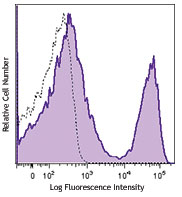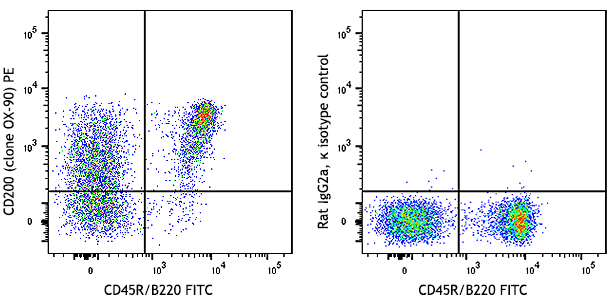- Clone
- BP-3 (See other available formats)
- Regulatory Status
- RUO
- Other Names
- cADPr hydrolase 2, Ly-65, BP-3, ADP-ribosyl cyclase 2
- Isotype
- Mouse IgG2b, κ
- Ave. Rating
- Submit a Review
- Product Citations
- publications

-

C57BL/6 mouse bone marrow cells were stained with CD45R/B220 FITC and CD157 (clone BP-3) APC (top) or mouse IGg2b, κ APC isotype control (bottom). Data shown was gated on the lymphoid cell population. -

| Cat # | Size | Price | Quantity Check Availability | Save | ||
|---|---|---|---|---|---|---|
| 140207 | 25 µg | 91€ | ||||
| 140208 | 100 µg | 261€ | ||||
CD157 is an ectoenzyme member of the ADP-ribosyl cyclase family, also known as ADP-ribosyl cyclase 2, BST-1 (bone marrow stromal cell antigen 1), BP-3 antigen. It has a molecular weight between 40 - 46 kD and is a GPI-linked cell membrane glycoprotein which is expressed as a homodimer. CD157 is expressed by macrophages, neutrophils, bone marrow stromal cells, endothelial cells, follicular dendritic cells, and T and B cell progenitors prior to the rearrangement of the antigen receptors. Besides the ectoenzyme activity, it also plays a role in neutrophil migration and adhesion.
Product DetailsProduct Details
- Verified Reactivity
- Mouse
- Antibody Type
- Monoclonal
- Host Species
- Mouse
- Immunogen
- Murine pre-B cell line 18.81
- Formulation
- Phosphate-buffered solution, pH 7.2, containing 0.09% sodium azide.
- Preparation
- The antibody was purified by affinity chromatography and conjugated with APC under optimal conditions.
- Concentration
- 0.2 mg/ml
- Storage & Handling
- The antibody solution should be stored undiluted between 2°C and 8°C, and protected from prolonged exposure to light. Do not freeze.
- Application
-
FC - Quality tested
- Recommended Usage
-
Each lot of this antibody is quality control tested by immunofluorescent staining with flow cytometric analysis. For flow cytometric staining, the suggested use of this reagent is ≤1.0 µg per million cells in 100 µl volume. It is recommended that the reagent be titrated for optimal performance for each application.
- Excitation Laser
-
Red Laser (633 nm)
- Application References
-
- McNagny KM, et al. 1988. J. Immunol. 141:2551. (FC)
- Product Citations
-
- RRID
-
AB_10901172 (BioLegend Cat. No. 140207)
AB_10901172 (BioLegend Cat. No. 140208)
Antigen Details
- Structure
- Member of the ADP-ribosyl cyclase family, ectoenzyme, 40-46 kD, glycosyl-phosphatidylinositol (GPI)- anchored membrane protein, present on the cell surface as a homodimer
- Distribution
-
Expressed by endothelial cells, follicular dendritic cells, cells from the myeloid lineage, and T and B cell precursors prior to the rearrangement of the antigen receptor. Expressed in many cell types from different tissues like the bone marrow, spleen, thymus, lung, kidney and heart.
- Function
- Synthesizes cyclic ADP-ribose (cADPR), a second messenger that elicits calcium release from intracellular stores.
- Cell Type
- B cells, Dendritic cells, Endothelial cells, T cells
- Biology Area
- Immunology, Innate Immunity
- Molecular Family
- CD Molecules
- Antigen References
-
1. Yamamoto-Katayama S, et al. 2002. J. Mol. Biol. 310:711.
2. Funaro A, et al. 2009. Front. Biosci. 14:929.
3. Malavasi F, et al. 2006. Mol. Med. 12:334.
4. Vicari AP, et al. 1996. Int. Immunol. 8:183. - Gene ID
- 12182 View all products for this Gene ID
- UniProt
- View information about CD157 on UniProt.org
Other Formats
View All CD157 Reagents Request Custom Conjugation| Description | Clone | Applications |
|---|---|---|
| Purified anti-mouse CD157 (BST-1) | BP-3 | FC |
| PE anti-mouse CD157 (BST-1) | BP-3 | FC |
| APC anti-mouse CD157 (BST-1) | BP-3 | FC |
| TotalSeq™-B1016 anti-mouse CD157 (BST-1) | BP-3 | PG |
Customers Also Purchased
Compare Data Across All Formats
This data display is provided for general comparisons between formats.
Your actual data may vary due to variations in samples, target cells, instruments and their settings, staining conditions, and other factors.
If you need assistance with selecting the best format contact our expert technical support team.
-
Purified anti-mouse CD157 (BST-1)

BALB/c bone marrow cells were stained with CD157 (BP-3) PE a... -
PE anti-mouse CD157 (BST-1)

BALB/c bone marrow cells were stained with CD157 (BP-3) PE a... -
APC anti-mouse CD157 (BST-1)

C57BL/6 mouse bone marrow cells were stained with CD45R/B220... 
-
TotalSeq™-B1016 anti-mouse CD157 (BST-1)
 Login / Register
Login / Register 

















Follow Us